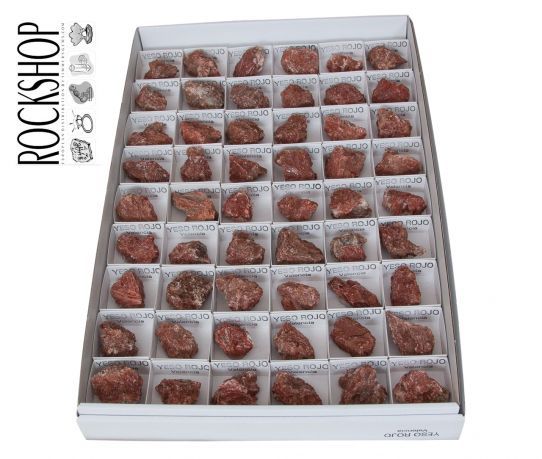We use cookies to make your experience better.
Red Gipsum from Spain "Rockshop" sales box with 54 pieces.
- Buy 3 for €69.00 each and save 13%
Gypsum (derived from the Greek γύψος, "chalk" or "gypsum") is a mineral consisting largely of calcium sulfate (CaSO4), a compound of the calcium and sulfate ions. In nature, calcium sulfate occurs in crystalline form as selenite and as alabaster. These forms have two molecules of crystal water in the crystal lattice: CaSO4 2H2O. Calcium sulphate can take several forms, but these have no effect on the chemical behavior of the substance. (CaSO4): di-hydrate, CaSO4 · 2H2O, the hardened gypsum or the gypsum crystals found in nature; hemi-hydrate, 2 CaSO4 · H2O or CaSO4 · ½H2O, calcium sulphate hemihydrate or dicalcium sulphate monohydrate, a gypsum powder that absorbs water of crystallization when water is added and thereby hardens again and forms the di-hydrate again; gamma anhydrate, CaSO4, the water-poor form. Used, among other things, for drying agents. beta anhydrate, CaSO4, the anhydrous form. Used as a filler in construction, among other things. When heating gypsum above 150 ° C, the mineral partially dehydrates: it loses water from its crystal lattice and hemi-hydrate is formed: CaSO4 2H2O → CaSO4 ½H2O (s) + 1½H2O or 2CaSO4 2H2O → (CaSO4) 2 H2O (s) + 3H2O If the hemi-hydrate is heated further (180 ° C), calcium sulphate is formed with very little crystal water. We then speak of the gamma anhydrate. When water is added, this changes back into the dihydrate. This is used, among other things, for drying agents. If the hemi-hydrate is heated even further (250 ° C), calcium sulphate is formed without water of crystallization. We then speak of beta anhydrate. This has a different crystal lattice than gamma anhydrate and does not absorb water, even over geological time spans. Plaster is soft. On the Mohs hardness scale, it has hardness two. With a fingernail one can make a scratch in plaster, which indicates that plaster is softer than nail. Gypsum occurs in nature and may contain thick deposits in rock layers. Because plaster is naturally very soft, it will erode quickly. If gypsum is present in the formation of a mountain, the gypsum layers will be under layers of rock layers of less erosive rocks such as sandstone and limestone. An example of a mountain that is partly made of plaster is the Dent du Villard. Because gypsum contains crystal water, it can be used as a fire retardant. Partly for this reason, plaster is often used in construction. It is therefore used as a flame retardant, for example in paint or ceiling elements. The flame retardancy mechanism is as follows. The energy (heat) of the fire releases the crystal water. CaSO4 · ½H2O first forms and at a sufficiently high temperature finally CaSO4. Plaster expands slightly when hardening (0.5%).












